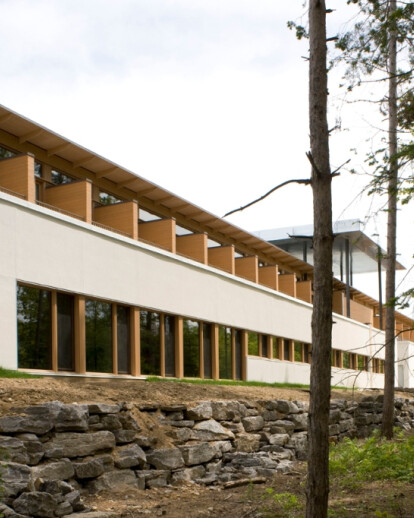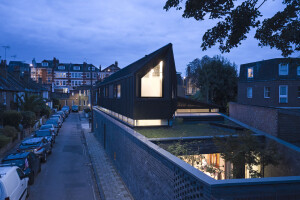"The traveler who climbs the paths of a high mountain sees the landscape slowly change before his eyes. Each turn reveals new, deep valleys rimmed by steep slopes. (...) Upon reaching the summit, the traveler, looking down and discovering a landscape until then masked by the mountain itself, is seized by the unprecedented vastness suddenly made clear to him." –Hubert Reeves
The Context of the Intervention
The new Cistercian Abbey of Saint-Jean-de-Matha strives to express the harmony and inner simplicity sought by Cistercian monks in their daily lives. At the centre of monastic life, hospitality, contemplation and prayer hold a privileged place. The seven daily offices punctuate a way of life regulated by prayer, while the passing of the seasons marks time.
Within this context, the new abbey of Saint-Jean-de-Matha addresses the complementary imperatives of introversion and extraversion. The sequential organization of functions within the project encourages inner reflection and privacy for both monks and guests, while the volumetric purity of the abbey responds to the landscape in a gesture that promotes the intertwining of natural and built elements. Thus, walkways, paths and corridors are impregnated with multiple sensations that see the subtle changes of landscape imparted to daily life.
The Architectural Component
In accordance with the way of life of Cistercian monks, the spaces of the new abbey largely encompass the cloister and culminate at the church, the focal point and heart of the project.
The concentric motion of the compound is traversed by the gatehouse, which features an east-west axis that extends beyond the buildings into the landscape on either side. Permeable from the north, the gatehouse links functions accessible to guests, specifically the guest house and the church. Together with the stone walls of the church, it shields the private areas of the monastery, thus sheltering the cloister around which are distributed those functions devoted exclusively to the monks.
The east-west axis, as a linear marker from one side of the abbey to the other, extends to a belvedere to the west and an observation tower to the east. The gesture contributes to defining the monks’ garden to the south, which overlooks a cliff, and the guests’ garden to the north, located beside the pond. The gardens incorporate a vegetable plot, a way of the cross and sites specifically devoted to contemplation, allowing monks and guests to take advantage of private moments of reflection in symbiosis with the majestic beauty of the site.
The shape of the complex, with one wing in extension, naturally indicates the main entrance of the monastery, underscored by the prolongation of the wide roof of the church. Under the roof, a mineral garden serves as a square for the church and the guest house. Extraversion: Paths and Walkways Intertwining the Landscape
The square, in a sweeping motion perpendicular to the east-west axis, further extends from north to south to create a succession of spaces that gradually shift from public to private, exploiting the monastery’s relationship with its site.
Originating beyond the pond, the progressively articulated landscape successively becoming a garden for guests, a reception area, a contemplative garden within the cloister walls and finally, at the extreme south, a garden of reflection and meditation for exclusively for monks. It begins in the parking area located in the clearing to the north and translates the momentum of spiritual life. The landscape eventually includes a rainwater basin that penetrates the cloister, running along one side of the cloister gallery. With sliding glass panels for cross ventilation, the gallery opens broadly onto the cloister yard and onto the silhouette of the church, the monastery’s focal point.
Introversion: Vertical Sequencing of Space
In both the cloister and the guest house, functions are sequenced vertically from bottom to top and from the collective to the individual. The ground floor thus features service-related and common rooms (parlors, meeting rooms, the refectory, the kitchen, a two-storey library, offices and a chapter room giving out onto a screened patio). Monks’ cells and the infirmary are located on the upper floor, which penetrates the church in the form of a mezzanine, accessible from the infirmary, and which contains the novice room and an observatory for monks. Spaces on this floor look out onto the forest and onto the green band of a living roof.
A vertical sequencing of simple, harmonious materials echoes the vertical sequencing of space. Common spaces are thus lodged among stone that speaks of perennial forces, while the upper floor, made of wood, houses private spaces for individual reflection.
Sequencing materials in this way not only serves to circumscribe functions, it also translates intentions with regard to sustainable development. Stone is used to house common spaces; it is modulated through alcoves that open onto the landscape, broadened to form niches or, in the chapter room, recessed to create a fireplace, conferring a spirit of solidity, sobriety and authenticity to the common rooms. On the ground, the concrete mass makes it possible to conserve energy through a radiant system fueled by wood. Wood paneling on the upper floor confers warmth and humanity to the cells and their integrated furnishings and lends itself well to the structural rhythm of the cells’ individual balconies. Landscape interventions such as the rainwater basin and the green roofs add spatial interest while serving to collect and recuperate grey water from the compound’s hygienic facilities.
Privacy and Community
The church, landmark and heart of the monastery, interprets in its own way the attributes of both stone and wood. Representing individual contemplation (wood) within the heart of the community (stone), it houses both materials in an ongoing dialogue bathed in natural light. Reaching to the sky, the stone volume of the church is paneled with a wood interior that controls the light and intensifies the acoustics. Glass openings in the stone walls and on the roof bring zenithal light to this site of celebration and communion.
The new Cistercian abbey of Saint-Jean-de-Matha, anchored in the landscape that cradles it, bears a clear message of inner harmony that is expressed both physically and spiritually. It stands out in its simplicity, economy of means and in its respect and consideration of the environment.





























